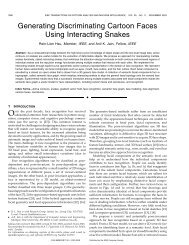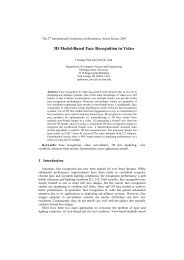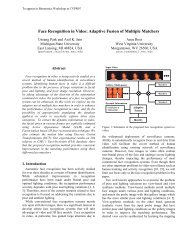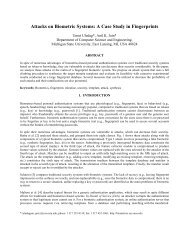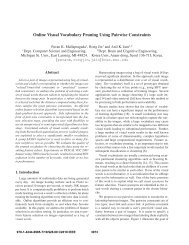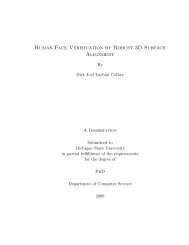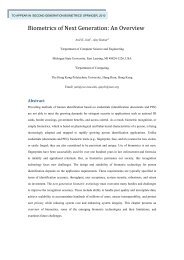Face Detection and Modeling for Recognition - Biometrics Research ...
Face Detection and Modeling for Recognition - Biometrics Research ...
Face Detection and Modeling for Recognition - Biometrics Research ...
Create successful ePaper yourself
Turn your PDF publications into a flip-book with our unique Google optimized e-Paper software.
4.4 Model Construction<br />
Our face modeling process consists of global alignment <strong>and</strong> local adaptation. Global<br />
alignment first brings the generic model <strong>and</strong> facial measurements into the same coordinate<br />
system. Based on the 3D head pose <strong>and</strong> the face size, the generic model is<br />
then scaled, rotated, <strong>and</strong> translated to fit the facial measurements. Figure 4.6 shows<br />
the global alignment results in two different modes. Local adaptation consists of local<br />
(a)<br />
Figure 4.6. Global alignment of the generic model (in red) to the facial measurements<br />
(in blue): the target mesh is plotted in (a) <strong>for</strong> a hidden line removal mode <strong>for</strong> a side<br />
view; (b) <strong>for</strong> a see-through mode <strong>for</strong> a profile view.<br />
(b)<br />
alignment <strong>and</strong> local feature refinement. Local alignment involves scaling <strong>and</strong> translating<br />
model features, such as eyes, nose, mouth, chin <strong>and</strong> face boundary to fit the<br />
extracted facial features. Local feature refinement makes use of two new techniques–<br />
displacement propagation <strong>and</strong> 2.5D active contours–to smooth the face model <strong>and</strong> to<br />
refine local features. The local alignment <strong>and</strong> the local refinement of each feature<br />
103



